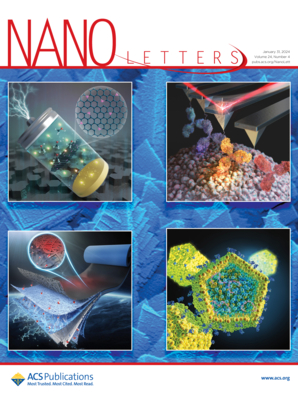IF 9.6
1区 材料科学
Q1 CHEMISTRY, MULTIDISCIPLINARY
引用次数: 0
摘要
设计具有可控特性和明确机制的纳米酶,对于推动下一代肿瘤治疗功能生物材料的发展具有重大意义。在这里,我们开发了一种由金属有机框架(MOF)衍生的双金属硫化物纳米酶 FCS,可通过光热和催化联合疗法进行铁治疗。FCS 是通过将沸石咪唑框架-67(ZIF-67)硫化到硫化钴(Co3S4,CS)中,然后进行亚铁阳离子交换合成的,从而增强了近红外 II 光热转换和卓越的芬顿催化活性。理论计算将这些增强归因于铁的掺杂,它缩小了带隙,促进了到 H2O2 的电子转移,并降低了活性氧生成的能垒。FCS 可通过脂质过氧化有效诱导铁变态反应,同时支持 T2 加权磁共振成像。这项研究提出了一种将 MOF 转化为多功能肿瘤治疗剂的稳健策略,突出了金属离子掺杂在优化纳米酶性能方面的作用。本文章由计算机程序翻译,如有差异,请以英文原文为准。

Multifunctional Hollow Bimetallic Sulfide Nanozyme Enables Imaging-Guided Synergistic Ferrotherapy for Tumor Treatment
The design of nanozymes with controlled properties and well-defined mechanisms holds significant promise for advancing next-generation functional biomaterials for tumor theranostics. Here, we develop a metal–organic framework (MOF)-derived bimetallic sulfide nanozyme, FCS, for ferrotherapy via combined photothermal and catalytic therapies. FCS is synthesized by vulcanizing the zeolitic imidazolate framework-67 (ZIF-67) into cobalt sulfide (Co3S4, CS), followed by ferrous cation exchange, resulting in enhanced near-infrared II photothermal conversion and superior Fenton-like catalytic activity. Theoretical calculations attribute these enhancements to Fe doping, which narrows the band gap, promotes electron transfer to H2O2, and lowers the energy barrier for active oxygen species generation. FCS effectively induces ferroptosis through lipid peroxidation, while supporting T2-weighted magnetic resonance imaging. This study presents a robust strategy for MOF transformation into multifunctional tumor theranostic agents, highlighting the role of metal ion doping in optimizing nanozyme performance.
求助全文
通过发布文献求助,成功后即可免费获取论文全文。
去求助
来源期刊

Nano Letters
工程技术-材料科学:综合
CiteScore
16.80
自引率
2.80%
发文量
1182
审稿时长
1.4 months
期刊介绍:
Nano Letters serves as a dynamic platform for promptly disseminating original results in fundamental, applied, and emerging research across all facets of nanoscience and nanotechnology. A pivotal criterion for inclusion within Nano Letters is the convergence of at least two different areas or disciplines, ensuring a rich interdisciplinary scope. The journal is dedicated to fostering exploration in diverse areas, including:
- Experimental and theoretical findings on physical, chemical, and biological phenomena at the nanoscale
- Synthesis, characterization, and processing of organic, inorganic, polymer, and hybrid nanomaterials through physical, chemical, and biological methodologies
- Modeling and simulation of synthetic, assembly, and interaction processes
- Realization of integrated nanostructures and nano-engineered devices exhibiting advanced performance
- Applications of nanoscale materials in living and environmental systems
Nano Letters is committed to advancing and showcasing groundbreaking research that intersects various domains, fostering innovation and collaboration in the ever-evolving field of nanoscience and nanotechnology.
 求助内容:
求助内容: 应助结果提醒方式:
应助结果提醒方式:


